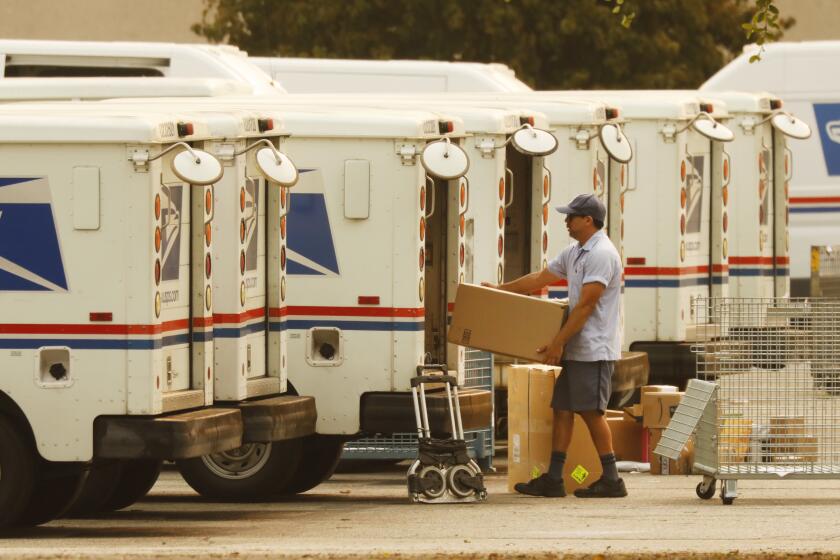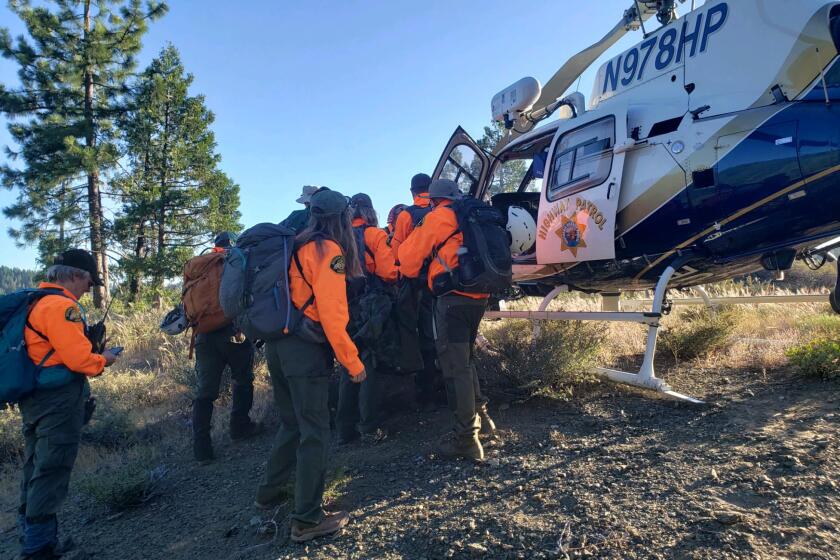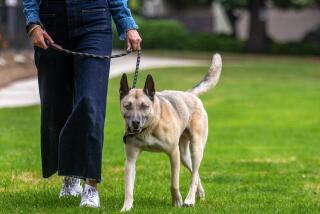Your dog doesn’t want you going to work or on vacation. How to handle separation anxiety

- Share via
Pandemic-related shutdowns in 2020 gave many people who believed they didn’t have time for pets the push they needed to adopt.
But with many offices haltingly bringing employees back and vacations in full swing, pet owners and people who work with dogs are starting to grapple with animals’ separation anxiety and other problems.
Nihcole Adams, a dog walker and sitter in Castaic, has had an uptick in new clients who are also new to dog ownership. She’s been fielding requests for walks, feedings and boardings. But some pets she’s taking in are struggling with being alone or socializing with other dogs.
Adams recently boarded a 5-month-old Lhasa Apso, Brody, for a week. The owners were worried Adams would call them to pick up their dog because he wouldn’t do well with the other pets. But when they picked the puppy up at the end of the week, they were surprised at his progress — Brody just needed to practice being in a social setting.
“Dogs who are isolated or not socialized prior to 16 weeks of age are more likely to develop behavior problems later on,” Rachel Malamed, a veterinary behavioral specialist, said.
The stakes are serious. Malamed said behavior problems are a leading cause of relinquishment and euthanasia.
But the new pet owners Adams works with are passionate about getting help for their dogs. It’s just that many don’t know where to start or what resources are available.
Seeking help from a qualified professional early on can help keep pets in the home, improve pet welfare and repair the human-animal bond, Malamed said.
Depending on your pup’s situation, you can seek help from certified dog trainers, a veterinarian or pet sitters. The Times spoke with all three about how to tell if a dog is experiencing separation anxiety, tips on what owners can do at home and beyond, and resources.
L.A.’s animal services agency is understaffed and relies on volunteers. At one overcrowded shelter, dogs sit in kennels for weeks or months without being walked.
Understanding your pet
Malamed said she’s seeing a lot of pets with separation anxiety as well as other fears and phobias — including the fears of people, noises, walks and other animals.
These fears, she said, can be due to a lack of early socialization caused by the pandemic.
Ingrid Komisar said they also can result from a lack of training as well as genetic predisposition. Komisar — a certified trainer for Calm Canine Academy, a virtual dog-training service — said the coronavirus lockdowns halted in-person trainings for many dogs and their owners. It also stopped many pets from simply seeing and interacting with other humans and dogs.
Anxiety in pets can manifest itself in a number of ways. Physical changes can look like loss of appetite, vomiting, diarrhea or house-soiling. Behavioral changes to be aware of may include hiding and avoidance, shaking, tail tucking, ears back, licking the lips and yawning, not taking treats readily and not following commands. In some cases pets will become aggressive to household members, unfamiliar people or other animals.
Don’t wait to see if the problem will go away. Most behavior problems worsen if left unaddressed.
“The first thing that people should do when they notice any behavioral or physical signs or change, especially those that are sudden or uncharacteristic for their pet, is to consult with their vet to make sure that there are no underlying medical reasons for these behaviors,” Malamed said.
Which beaches in Los Angeles and Orange counties allow dogs? Check our list to find out.
How can a veterinarian help?
Karen Sueda, a veterinary specialist in the behavior department at VCA West Los Angeles Animal Hospital, said illness can affect your pet’s behavior, so it’s important to rule out physical causes first.
“For example, many diseases can cause house-soiling, and a dog that is in pain may pant, vocalize and appear anxious,” Sueda said.
A vet visit allows the doctor to ask specific questions to make an accurate behavioral diagnosis and create a treatment plan if a physical cause has been ruled out, she said.
If the problem behavior is mild, your veterinarian may refer you to a trainer who uses positive-reinforcement training techniques. Sueda said that if the problem is more concerning, the doctor might refer you to a veterinary behaviorist — a specialist in treating behavioral issues in pets.
Veterinarians also may prescribe medications that reduce anxiety. Lowering anxiety, Sueda said, allows the pet to learn new behaviors and coping strategies through positive reinforcement.
Last year mail carriers in California reported 656 dog biting attacks — the highest in the nation. Among cities, Los Angeles ranked fourth.
Training techniques
If your veterinarian recommends a trainer for your dog’s separation anxiety, Komisar advises finding a certified professional. The American Veterinary Society of Animal Behavior has tips on how to choose a trainer based on specialty.
Komisar acknowledges that a dog dealing with separation anxiety can be incredibly distressing for the owner too.
But separation anxiety is treatable.
“If we put in the time, if we put in the effort, it is possible to see success and to see [your pet] start to be comfortable with alone time,” she said.
How much time and effort? Komisar said she usually tells clients that the process can take months.
Through Calm Canine Academy, she starts with suspending absences — so if you have to go to work or school and don’t have someone who can stay with your dog, hire a pet sitter.
Next, Komisar works with the owner to understand at what point the dog begins to panic. If it’s within 10 minutes of the owner leaving home, then they’ll start by training the dog to be comfortable being alone for less than 10 minutes and work their way up.
April showers bring ... mosquitoes. Here are some pointers to help keep them away from your home. Pro tip: Do not leave pools of standing water on your property.
What you can do at home now
If your dog is showing mild signs of separation anxiety or if you’re waiting for your scheduled veterinarian appointment, Ralf Weber, a certified dog trainer based in Corona, shared tips on what you can do at home.
- For five minutes a day, everyone in the home ignore the dog. The animal may whine or bark but eventually will entertain itself or lie down. Once the dog is comfortable at five minutes, gradually increase the time.
- Having your dog crate-trained is valuable. A crate is a dog’s own comfortable space, away from the owner. It’s also needed when transporting your pet, leaving them at a kennel or if they have to stay at the veterinarian’s office.
- Similar to Komisar’s technique of leaving your pet alone for however long the pet is comfortable with, Weber recommends gradually increasing the dog’s alone time. But don’t rush the process; go at your dog’s pace.
Nevada County Sheriff’s Search and Rescue team was led by a dog at Tahoe National Forest to find his injured owner.
More resources
- Certification Council for Professional Dog Trainers helps you find a certified dog trainer near you.
- Wag! helps you locate dog walkers, boarders and trainers nearby.
- Rover has listings for boarding, house sitting, dog walking, doggy day care and drop-in visits (to feed, play or give bathroom breaks).
Once upon a time — before P-22 or Grumpy Cat — a rogue gator lurked in an L.A. lake. He was captured 15 years ago today. Where is he now?
About The Times Utility Journalism Team
This article is from The Times’ Utility Journalism Team. Our mission is to be essential to the lives of Southern Californians by publishing information that solves problems, answers questions and helps with decision making. We serve audiences in and around Los Angeles — including current Times subscribers and diverse communities that haven’t historically had their needs met by our coverage.
How can we be useful to you and your community? Email utility (at) latimes.com or one of our journalists: Jon Healey, Ada Tseng, Jessica Roy and Karen Garcia.
More to Read
Sign up for The Wild
We’ll help you find the best places to hike, bike and run, as well as the perfect silent spots for meditation and yoga.
You may occasionally receive promotional content from the Los Angeles Times.

















